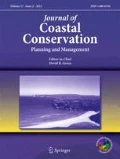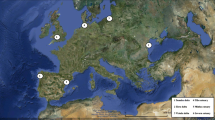Abstract
The Dutch Delta Region (S-W Netherlands) originally consisted of interconnected estuaries, interfacing the rivers Rhine, Meuse and Schelde with the North Sea. The ecosystems were immature, with physical rather than biological control of population dynamics. Main functions were shipping and shellfisheries. An emergent function of the interconnected estuaries was the buffering and upgrading of riverborne substances before they entered the sea.
Execution of the Delta Project in the period 1960–1986 resulted in isolation of several water systems disconnected from rivers and sea, and loss of gradients within these systems. Population dynamics were now controlled by chemical and biological rather than physical factors. Vulnerability to external perturbation increased. These changes also affected the buffering capacity, i.e. reduced the utility of the area as stabiliser of the geosystem. Recreational use and appreciation of natural values increased, potentially conflicting with shipping and shellfisheries.
Retrospective analysis of the environmental policy and management revealed three consecutive strategies in the Delta Project. 1. Reactive one-issue management, focusing on safety against flooding only. This strategy aimed at complete closure of the estuaries thus transforming them into fresh water lakes. It has destroyed feed-backs and buffering between coastal and inland waters. This strategy has not promoted sustainable development and has increased the vulnerability of the area to future catastrophes. 2. Protective bio-ecological management focused on the preservation of existing values of landscape and environment, and resulted in the maintenance of saline conditions and preservation of marshes by shore protection measures. The drawback of this passive orientation to existing values Ôwhere they are nowÕ is the necessity of continuous intensive care because the natural adaptive ability is not being restored. 3. Constructive geo-ecological management is based on understanding functional properties within and between ecosystems as integrated elements of the landscape structure. This strategy aims at environmental protection, restoration and development of values Ôwhere they must beÕ. Re-establishment of gradients by e.g. re-introducing tidal influence and by restoring salt marshes should contribute to sustainable development.
Similar content being viewed by others
References
Anon. 1990.ECOLUMN: Ecological column model for marine system nutrient dynamics. Delft Hydraulics, Report T650, Delft.
Bakker, C. & Vink, M. 1994. Nutrient concentrations and planktonic diatom-flagellate relations in the Oosterschelde (S.W.Netherlands) during and after the construction of a storm-surge barrier.Hydrobiologia 282/283: 101–116.
Bakker, C., Herman, P.M.J. & Vink, M. 1994. A new trend in the development of the phytoplankton in the Oosterschelde (SW Netherlands) during and after the construction of a storm surge-barrier.Hydrobiologia 282/283: 79–100.
Balls, P.W. 1994. Nutrient inputs to estuaries from nine Scottish East coast rivers; influence of estuarine processes on inputs to the North Sea.Estuarine Coast. Shelf Sci. 39: 329–352.
Bollebakker, G.P. & van de Kamer, J.P.G. 1989.IJking en validatie van het stratificatiemodel STRESS-Veerse Meer en toepassing van het model voor de beleidsanalyse Veerse Meer. Rijkswaterstaat Tidal Waters Division, Report GWWS-88.411, Middelburg.
CadŽe, N. 1994.Typologie van estuariene systemen: geografische referentie voor het Schelde estuarium. Report RIKZ-94.048, The Hague.
Conley, D.J., Smith, W.M., Cornwell, J.C. & Fisher, T.R. 1995. Transformation of particle-bound phosphorus at the Land-Sea interface.Estuartine Coast. Shelf Sc. 40: 161–176.
de Jong, D.J., Nienhuis, P.H. & Kater, B.J. 1994a. Microphytobenthos in the Oosterschelde (The Netherlands) 1981–1990; consequences of a changed tidal regime.Hydrobiologia 282/283: 183–195.
de Jong, D.J., de Jong, Z. & Mulder, J.P.M. 1994b. Changes in area, geomorphology and sediment nature of salt marshes in the Oosterschelde estuary (SW Netherlands) due to tidal changes.Hydrobiologia 282/283: 303–316.
de Vries, I., Hopstaken, F., Goossens, H., de Vries, M., de Vries, H. & Heringa, J. 1988a.GREWAQ: an ecological model for Lake Grevelingen. Delft Hydraulics, Report T215-03, Delft.
de Vries, I., van Raaphorst, W. & Dankers, N. 1988b. Extra voedingsstoffen in zee: gevolgen, voordelen, nadelen.Landschap 5: 270–285.
de Vries, I., de Vries, M. & Goossens, H. 1990.Ontwikkeling en toepassing VEERWAQ ten behoeve van beleidsanalyse Veerse Meer. Delft Hydraulics, Report T430, Delft.
de Vries, I., Philippart, C.J.M., DeGroodt, E.G. & van der Tol, M.W.M. 1995. Coastal eutrophication and marine benthic vegetation. In: Schramm, W. & Nienhuis, P.H. (eds.)Marine benthic vegetation. Recent changes and the effects of eutrophication. Ecological studies, Vol. 123, pp. 79–114. Springer Verlag, Berlin.
Dugdale, R.C. & Goering, J.J. 1967. Uptake of new and regenerated forms of nitrogen in primary productivity.Limnol. Oceanogr. 12: 196–206.
Froelich, P.N. 1988. Kinetic control of dissolved phosphate in natural rivers and estuaries: a primer on the phosphate buffer mechanism.Limnol. Oceanogr. 33: 826–832.
Goossen, N., van Rijswijk, P., Peene, J. & Kromkamp, J. 1992. Annual patterns of bacterial production in the Scheldt estuary (S.W. Netherlands). In: Herman, P.M.J. (ed.)JEEP 92: Major biological processes in European tidal estuaries, pp. 109–113. MAST. NIOO report, Yerseke.
Harrison, W.G., Douglas, D., Falkowski, P., Rowe, G. & Vidal, J. 1983. Summer nutrient dynamics of the middle Atlantic Bight: nitrogen uptake and regeneration.J. Plankton Res. 5: 539–556.
Kavaliauskas, P. 1995. The nature frame / Lithuanian experience.Landschap 12(3): 17–26.
Klepper, O., van der Tol, M.W.M., Scholten, H. & Herman, P.M.J. 1994. SMOES: A simulation model for the Oosterschelde ecosystem. Part I: Description and incertainty analysis. In: Nienhuis, P.H. & Smaal, A.C. (eds.) The Oosterschelde estuary (The Netherlands): A case-study of a changing ecosystem.Hydrobiologia 282/283: 437–451.
Kromkamp, J., van Spaendonk, A., Peene, J., van Rijswijk, P. & Goosen, N. 1992. Light, nutrient and phytoplankton primary production in the eutrophic, turbid Westerschelde estuary. In Herman, P.M.J. (ed.)JEEP 92: Major biological processes in European tidal estuaries, pp. 115–126. MAST. NIOO report, Yerseke.
Mann, K.H. 1988. Production and use of detritus in various freshwater, estuarine and coastal marine ecosystems.Limnol. Oceanogr. 33: 910–930.
Mees, J., Dewicke, A. & Hamerlynck, O. 1992. Seasonal composition and spatial distribution of hyperbenthic communities along estuarine gradients in the Westerschelde. In: Herman, P.M.J. (ed.).JEEP 92: Major biological processes in European tidal estuaries, pp. 93–107. MAST. NIOO report, Yerseke.
Meire, P.M., Seys, J., Ysebaert, T., Meininger, P.L. & Baptist, H.J.M. 1989. A changing Delta: Effects of large coastal engineering works on feeding ecological relationships as illustrated by waterbirds. In: Hooghart, J.C. & Posthumus, C.W.S. (eds.)Hydro-ecological relations in the Delta Waters of the South-West Netherlands. CHOTNO proceedings and information no. 41: 109–145, Delft.
Meire P.M., Seys, J., Buys, J. & Coosen, J. 1994a. Spatial and temporal patterns of intertidal macrobenthic populations in the Oosterschelde: are they influenced by the construction of the storm-surge barrier?Hydrobiologia 282/283: 157–182.
Meire, P.M., Schekkerman, H. & Meininger, P.L.M. 1994b. Consumption of benthic invertebrates by waterbirds in the Oosterschelde estuary, SW Netherlands.Hydrobiologia 282/283: 525–546.
Nielsen, K., Nielsen, L.P. & Rasmussen, P. 1995. Estuarine nitrogen retention independently estimated by the denitrification rate and mass balance methods: a study of Norsminde Fjord, Denmark.Mar. Ecol. Prog. Ser. 119: 275–283.
Nienhuis, P.H. 1993. Nutrient cycling and foodwebs in Dutch estuaries.Hydrobiologia 265: 15–44.
Nienhuis, P.H. & Smaal, A.C. (eds.) 1994. The Oosterschelde estuary (The Netherlands): A case-study of a changing ecosystem.Hydrobiologia, 282/283.
Smaal, A.C. & Nienhuis, P.H. 1992. The Eastern Scheldt (The Netherlands), from an estuary to a tidal bay: a review of responses at the ecosystem level.Neth. J. Sea Res. 30: 161–173.
Soetaert, K., Herman, P.M.J. & Scholten, H. 1992. MOSES: Model of the Scheldt estuary. In: Herman, P.M.J. (ed.)JEEP 92: Major biological processes in European tidal estuaries, pp. 137–148. MAST. NIOO report, Yerseke.
Tackx, M.L.M., Herman, P.M.J., van Rijswijk, P., Vink, M. & Bakker, C. 1994. Plankton size distributions and trophic relations before and after the construction of the stormsurge barrier in the Oosterschelde estuary.Hydrobiologia 282/283: 145–152.
van der Tol, M.W.M. & Scholten, H. 1992. Response of the Eastern Scheldt ecosystem to a changing environment: functional or adaptive.Neth. J. Sea Res. 30: 175–190.
van Stralen, M.R. & Dijkema, R.D. 1994. Mussel culture in a changing environment: the effects of a coastal engineering project on mussel culture (Mytilus edulis L.) in the Ooster-schelde estuary (SW Netherlands).Hydrobiologia 282/283: 359–379.
Wassmann, P. 1986. Benthic nutrient regeneration as related to primary productivity in the west Norwegian coastal zone.Ophelia 26: 443–456.
Wetsteyn, L.P.J.M. & Kromkamp, J.C. 1994. Turbidity, nutrients and phytoplankton primary production in the Oosterschelde (The Netherlands) before, during and after a large scale engineering project (1980–1990).Hydrobiologia 282/283: 61–78.
Author information
Authors and Affiliations
Corresponding author
Rights and permissions
About this article
Cite this article
de Vries, I., Smaal, A.C., Nienhuis, P.H. et al. Estuarine management strategies and the predictability of ecosystem changes. J Coast Conserv 2, 139–148 (1996). https://doi.org/10.1007/BF02905199
Received:
Revised:
Accepted:
Issue Date:
DOI: https://doi.org/10.1007/BF02905199




